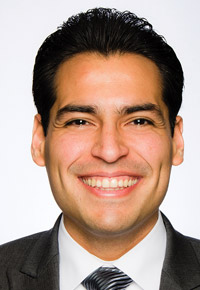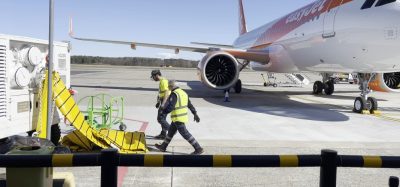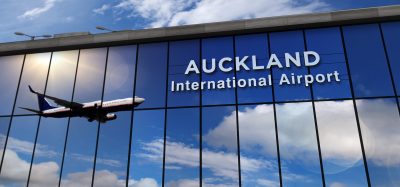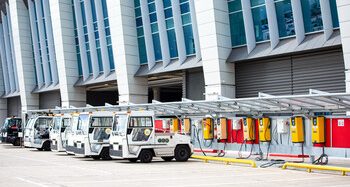Airfield ground handling: Choosing the right partner
- Like
- Digg
- Del
- Tumblr
- VKontakte
- Buffer
- Love This
- Odnoklassniki
- Meneame
- Blogger
- Amazon
- Yahoo Mail
- Gmail
- AOL
- Newsvine
- HackerNews
- Evernote
- MySpace
- Mail.ru
- Viadeo
- Line
- Comments
- Yummly
- SMS
- Viber
- Telegram
- Subscribe
- Skype
- Facebook Messenger
- Kakao
- LiveJournal
- Yammer
- Edgar
- Fintel
- Mix
- Instapaper
- Copy Link
Posted: 2 June 2016 | Ricardo Aitken, Stuart Matheson | 1 comment
With the streamlining of operational costs and consumers looking for ever more customised services, airports are increasingly looking towards new ground services providers to assist day-to-day operations. Ricardo Aitken and Stuart Matheson, from IATA, believe that there are seven golden rules of ground service Request for Proposal management…


With the streamlining of operational costs and consumers looking for ever more customised services, airports are increasingly looking towards new ground services providers to assist day-to-day operations. But introducing ground handling competition can inevitably alter a business’s dynamic. Ricardo Aitken and Stuart Matheson, from IATA, believe that there are seven golden rules of ground service RfP (Request for Proposal) management.
Not so long ago, independent ground handling was limited in scope. Handling operations were largely dominated by airlines and airport handling supplier monopolies were the norm. Nowadays, with the overall trend towards liberalisation to create an even playing field combined with consumers’ individual needs for customised services (e.g. low-cost vs ‘full service’) and their streamlining of operational costs, the market has changed. The ground handling business now has more than 1,000 players worldwide, all fighting for their piece of the US$80 billion per annum ground handling business market pie. This is set to grow as the demand for higher safety and service levels, as well as leaner costs, is a continual driver for customers and providers alike – all the more reason to ensure that one is not sacrificed for the other.
The ground handling business now has more than 1,000 players worldwide
A large number of airports still use just one ground handling supplier, however European Union regulations dating back to 1999 require airports with traffic over a certain number of passengers to offer additional licenses to avoid any perceived monopoly. Although this is not the case all over the world, there is strong evidence to suggest that by introducing more choice to customer airlines, overall costs reduce and quality increases as the market becomes more competitive. That said, it is important to ensure that the market is large enough to sustain multiple suppliers. There is evidence from airlines to suggest that introducing such ground handling competition attracts new airlines and/or encourages expansion of existing operations at airports where the market is more liberalised.
However, it is very important that airports and airlines looking for a new service provider (or attempting to increase the number of ground handling service suppliers to their business) be aware that in seeking proposals, it will inevitably lead to a change in the dynamics within their business. Whether this means an effect on existing supplier relationships, due to increasing the number of suppliers they have to manage, or the stress of expanding into new territories (either geographically or corporately), acquisition of new or additional ground handling services is highly likely to have a significant impact on the status quo and, as such, there is a vital need to be prepared to deal with this change.
The seven golden rules…
Below are seven golden rules any entity seeking to expand its ground handling operations provision in a viable and profitable way should consider when developing a Request for Proposal (RfP) from potential bidders.
Ask your stakeholders
An essential first step in RfP process management is to ask stakeholders (airlines, staff, etc.) what they want. Although this sounds very basic it is an aspect that is often neglected. The granting of operating licenses is one thing, but will the airlines actually sign a commercial deal? Will the introduction of a new supplier interfere with settled existing relationships? Will the market become so cut-throat that the overall level of safety and quality is sacrificed on the altar of profitability? Do the airlines actually want another supplier? These are important questions ground handling service providers need answered and will go a long way towards achieving transparency. There is little point going through the intensive RfP process to select a supplier if they are selected against criteria with no input from stakeholders. How can such a process provide a good fit for your operation? Open and honest communication, whether it be through existing relationships or via an established contact channel from a trusted third party or organisation, is essential to maximise the benefits at these early stages of conducting a ground handling RfP.
Conduct a thorough inventory of infrastructure and GOM/SOP requirements
A thorough inventory of airport infrastructure and assets is a must. Any entity considering running a ground handling RfP needs to appreciate that having the appropriate equipment and infrastructure makes the difference in achieving high operational efficiency and reducing environmental impact. A ground handling RfP provides the perfect time to upgrade and encourage new operators to invest in positive change. Both airports and airlines need to take into consideration what equipment they would like to see introduced into their operations as their new service provider begins to operate, and if it fits well with their strategy going forward, as well as what is already in place. Consider, for example, whether electric vehicle investment is desirable; what type of IT interface is required; and, more importantly, how this will integrate with existing ‘common user’ facilities. On-site observations and individual meetings with existing stakeholders are key methods for obtaining a better understanding of operational challenges and opportunities.
In addition, a review of the existing Ground Handling Policy and Procedures Framework is needed. The basic framework should cover more than the basic Ground Operations Manuals (GOMs) and Standard Operating Procedures (SOPs), and must incorporate:
- International/ National Legislation
- Company Policy Level
- Airline Specificity
- Local Procedures (LOP).
It is imperative that in any GOM/SOP manuals, the requirements of ISAGO (or similar regulations) are imbedded at an early stage. The benefit is two-fold:
- It prevents additional cost of procedure revision to gain compliance
- It adds rigour to the GOM/SOPs to ensure compliance across a growing and diverse business.
It is also important to be aware that all GOM/SOPs are designed to be working documents. In other words, they are works-in-progress in an evolving workplace, to which regular revisions must be issued in order to avoid becoming obsolete, thus ensuring safety, training and operational delivery are aligned at all times with clients’ needs and the most recent industry best practice.
Provide the right data for proper business case development
Developing the right business case will attract the top-tier ground handling service operators to your RfP project. You have to make it worth their while and effort to actually participate. One thing to understand is the importance of providing the right annexes to the main RfP document. Too often the random, high level statistics provided by airports do not provide an adequate picture of the current business environment. The RfP annexes should include detailed traffic statistics, traffic forecasts and current facility and equipment inventory in a summarised and easy-to-read format that helps potential suppliers accelerate their initial decision – whether to participate or not.
Another important aspect of proper business case development is ensuring that the incumbent supplier does not have an unfair advantage and that the future ‘field of play’ will be level for everyone. The RfP should either demand no more onerous conditions than are already placed on existing licensees, or if an airline wishes to increase the conditions, they must be applied to all licensees – existing and otherwise. As previously mentioned, airports should involve their customer airlines and other stakeholders from the very beginning.
Conduct in-depth applicant due diligence
When choosing suppliers it is imperative to carry out thorough due diligence on the applicants to ensure they can meet your organisation’s handling needs, and are a trustworthy, viable business partner for the future. The use of benchmarking and a system of internationally recognised safety and quality certification, such as IATA’s ISAGO accreditation, is great for confirming the ability, safety record and viability of the bidders. Consider whether tangible systems, such as a safety management system, are in place; whether hazard reports are submitted voluntarily from all levels of the airport community; and how a new entrant will fit into the current framework?
However, it is also important to have an in-depth knowledge of the sector and to understand if the proposed services will suit the operation in question. This can be achieved by requesting specific industry relevant documents from the applicants and conducting some type of matric evaluation to help weed out the inappropriate candidates.
Have a realistic expectation of RfP management resources
The management of any RfP project will take up valuable time and resources. This can be strenuous given that airports and airlines are already running a complex business. Questions must be answered by asking the appropriate stakeholder or internal expert/decision maker; the current (or projected) operational deficiencies or needs must be carefully examined; the appropriate data must be collated; documentation must be prepared and reviewed… these are just a few of the areas that require expertise and resources to compile. Conducting a proper RfP will generate a lot of new tasks that will be a significant drain on existing resources. It may also be the case that the specific expertise required to conduct such a project is not available internally. After all, everyone has a ‘day job’ and designing, managing and selecting a new ground services provider through an RfP programme is not a core business activity in most cases. However, it is something which, if done properly the first time, will have a long-term positive effect on any airport’s or airline’s business. As such, this is a strong reason for engaging a third party expert to run the project.
Think about life after the RfP
Once a new license is awarded, there will be a change in the old order. This could mean yet another supplier to manage or the handover from ‘old’ to ‘new’, in the case of replacement. Both will have infrastructure, organisational, resourcing and human effects for all parties involved.
A ‘bedding in’ period for the new supplier as they begin operating will be inevitable so it’s important to consider how that will be managed and a contingency plan should be put in place with increased oversight applied accordingly.
There will inevitably be a change in dynamic – and the resources and support required will need to come from the new supplier, you and your stakeholders. The trick is to have run a stringent RfP which enables you to understand what is being offered by bidders and also how they plan to reduce the impact of change as they start operations. From this you can plan your actions and resources accordingly.
Finally do also consider the people who will be affected by your decisions. As humans we are all a little frightened of change and it is important to accentuate the positives and ensure they are delivered.
Consider the use of independent experts
An independent expert body will reassure all parties involved that the entire RfP process is professionally designed and administered and that final decisions are made on a fair and objective basis. This can be very important when the RfP is airport organised and the end result will be used by third parties, such as airlines, who may have little input into the decision making process. Likewise, any incumbent suppliers will feel that without a more independent approach, the appetite for ‘change for change’s sake’ can undermine their success as a bidder. The use of established tender management services solutions programmes such as those provided by IATA go a long way towards smoothing the entire process through a transparent and open approach. This is important in order to prevent final supplier selection from being liable to legal challenge in any regard.
Based on specialised expertise, independent experts can help identify weak areas, improve the feeling of partnership with clients/providers and successfully manage expectations. They can ensure successful integration with existing suppliers and stakeholders and streamline communication within airport operations and along the entire airport supply chain.
As stated at the beginning of this article, it is important that any organisation launching a ground handling RfP programme appreciates the change in the dynamic of their business – both directly and indirectly. A holistic and comprehensive approach is needed and can best be delivered on time, in a dedicated and professional way, and within strict budgets, by a proven and recognised expert in the field of both aviation and RfP management, such as IATA.
Biographies
|
|




















How do you go about choosing the right GHA as an airline carrier?